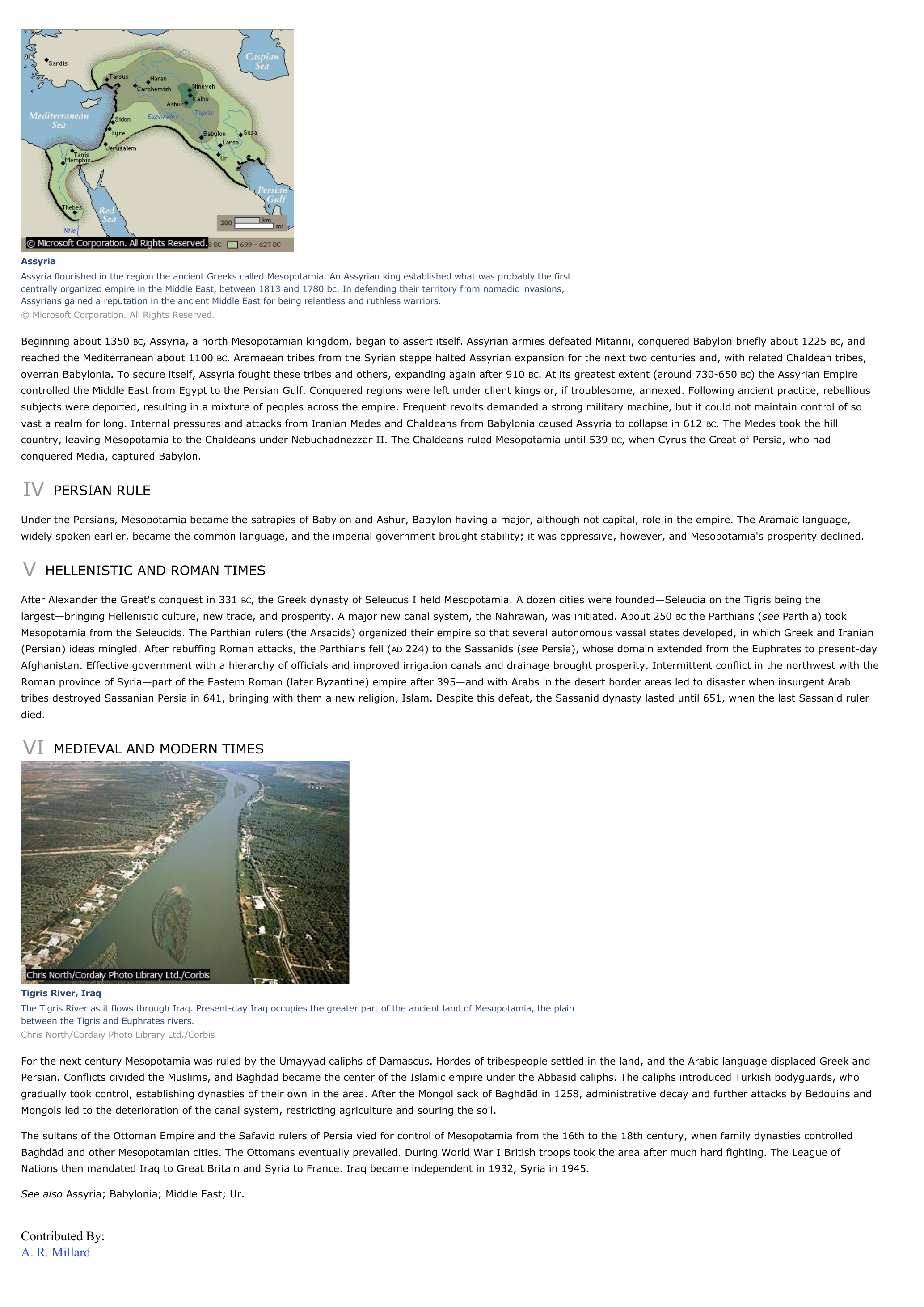Mesopotamia - history.
Publié le 26/05/2013

Extrait du document
«
AssyriaAssyria flourished in the region the ancient Greeks called Mesopotamia.
An Assyrian king established what was probably the firstcentrally organized empire in the Middle East, between 1813 and 1780 bc.
In defending their territory from nomadic invasions,Assyrians gained a reputation in the ancient Middle East for being relentless and ruthless warriors.© Microsoft Corporation.
All Rights Reserved.
Beginning about 1350 BC, Assyria, a north Mesopotamian kingdom, began to assert itself.
Assyrian armies defeated Mitanni, conquered Babylon briefly about 1225 BC, and reached the Mediterranean about 1100 BC.
Aramaean tribes from the Syrian steppe halted Assyrian expansion for the next two centuries and, with related Chaldean tribes, overran Babylonia.
To secure itself, Assyria fought these tribes and others, expanding again after 910 BC.
At its greatest extent (around 730-650 BC) the Assyrian Empire controlled the Middle East from Egypt to the Persian Gulf.
Conquered regions were left under client kings or, if troublesome, annexed.
Following ancient practice, rebellioussubjects were deported, resulting in a mixture of peoples across the empire.
Frequent revolts demanded a strong military machine, but it could not maintain control of sovast a realm for long.
Internal pressures and attacks from Iranian Medes and Chaldeans from Babylonia caused Assyria to collapse in 612 BC.
The Medes took the hill country, leaving Mesopotamia to the Chaldeans under Nebuchadnezzar II.
The Chaldeans ruled Mesopotamia until 539 BC, when Cyrus the Great of Persia, who had conquered Media, captured Babylon.
IV PERSIAN RULE
Under the Persians, Mesopotamia became the satrapies of Babylon and Ashur, Babylon having a major, although not capital, role in the empire.
The Aramaic language,widely spoken earlier, became the common language, and the imperial government brought stability; it was oppressive, however, and Mesopotamia's prosperity declined.
V HELLENISTIC AND ROMAN TIMES
After Alexander the Great's conquest in 331 BC, the Greek dynasty of Seleucus I held Mesopotamia.
A dozen cities were founded—Seleucia on the Tigris being the largest—bringing Hellenistic culture, new trade, and prosperity.
A major new canal system, the Nahrawan, was initiated.
About 250 BC the Parthians ( see Parthia) took Mesopotamia from the Seleucids.
The Parthian rulers (the Arsacids) organized their empire so that several autonomous vassal states developed, in which Greek and Iranian(Persian) ideas mingled.
After rebuffing Roman attacks, the Parthians fell ( AD 224) to the Sassanids ( see Persia), whose domain extended from the Euphrates to present-day Afghanistan.
Effective government with a hierarchy of officials and improved irrigation canals and drainage brought prosperity.
Intermittent conflict in the northwest with theRoman province of Syria—part of the Eastern Roman (later Byzantine) empire after 395—and with Arabs in the desert border areas led to disaster when insurgent Arabtribes destroyed Sassanian Persia in 641, bringing with them a new religion, Islam.
Despite this defeat, the Sassanid dynasty lasted until 651, when the last Sassanid rulerdied.
VI MEDIEVAL AND MODERN TIMES
Tigris River, IraqThe Tigris River as it flows through Iraq.
Present-day Iraq occupies the greater part of the ancient land of Mesopotamia, the plainbetween the Tigris and Euphrates rivers.Chris North/Cordaiy Photo Library Ltd./Corbis
For the next century Mesopotamia was ruled by the Umayyad caliphs of Damascus.
Hordes of tribespeople settled in the land, and the Arabic language displaced Greek andPersian.
Conflicts divided the Muslims, and Baghdād became the center of the Islamic empire under the Abbasid caliphs.
The caliphs introduced Turkish bodyguards, whogradually took control, establishing dynasties of their own in the area.
After the Mongol sack of Baghd ād in 1258, administrative decay and further attacks by Bedouins andMongols led to the deterioration of the canal system, restricting agriculture and souring the soil.
The sultans of the Ottoman Empire and the Safavid rulers of Persia vied for control of Mesopotamia from the 16th to the 18th century, when family dynasties controlledBaghd ād and other Mesopotamian cities.
The Ottomans eventually prevailed.
During World War I British troops took the area after much hard fighting.
The League ofNations then mandated Iraq to Great Britain and Syria to France.
Iraq became independent in 1932, Syria in 1945.
See also Assyria; Babylonia; Middle East; Ur.
Contributed By:A.
R.
Millard.
»
↓↓↓ APERÇU DU DOCUMENT ↓↓↓
Liens utiles
- Mesopotamia - History.
- Ideology and Rationality in the History of the Life Sciences
- HISTOIRE DU RÈGNE DE L'EMPEREUR CHARLES-QUINT [The History of the Reign of the Emperor Charles V].
- HISTOIRE DU MONDE [History of the World].
- GRANDISON (L') [The History of sir Charles Grandison]. (résumé)












